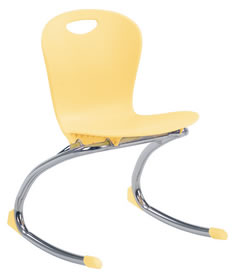Monarch Rocks
The Benefits of Rocking in the Classroom
 "Healthy" movement refers to safe and accessible opportunities for motion that help everyone feel organized, alert, fit and ready to learn. A young developing brain requires various types of motion to develop important foundational skills for learning. The sensory system that responds to movement helps to coordinate the eyes, hands and body for fine motor and gross motor activities. Many of us move or fidget unconsciously when working. Sometimes we tap our feet, shake our legs, or change positions when seated. These are all unconscious strategies we use to help us pay attention. Some students may need more movement than their peers to help them organize their bodies for school work. The rhythmical sway of a rocking chair can have calming and organizing effects that will help a child to “settle in” and be ready to work.
"Healthy" movement refers to safe and accessible opportunities for motion that help everyone feel organized, alert, fit and ready to learn. A young developing brain requires various types of motion to develop important foundational skills for learning. The sensory system that responds to movement helps to coordinate the eyes, hands and body for fine motor and gross motor activities. Many of us move or fidget unconsciously when working. Sometimes we tap our feet, shake our legs, or change positions when seated. These are all unconscious strategies we use to help us pay attention. Some students may need more movement than their peers to help them organize their bodies for school work. The rhythmical sway of a rocking chair can have calming and organizing effects that will help a child to “settle in” and be ready to work.
What is the role of "healthy movement" in a classroom?
Parents and adults tend to want children to "sit still." The reality is no one sits without moving for very long, because if we keep our bodies completely inactive, we tend to fall asleep or zone out. Dynamic sitting involves making adjustments to our position for comfort and moving our arms, legs, and body while we are sitting, in order to keep ourselves alert and engaged. Children who have access to healthy movement are more likely to stay engaged and to have better attention and behavior.
If children have chairs that move at school, won't they be disruptive?
Children are already moving in their chairs because they need movement to stay alert. In static chairs many children tend to tilt backwards, lean forward, swing their legs and sit on the edge of their chairs or on their knees. Studies have shown that after about a 2 week "settling in" period, children with access to chairs that provide healthy movement only move as needed to stay comfortable and to attend to lessons throughout the day. In fact, several studies suggest that children show better ability to stay seated, with less disruptive movements, when they have access to chairs that offer healthy movement.
Is healthy movement the same as ergonomics?
The term "ergonomics" usually is used in reference to the proper fit of furniture for the human body and the way it moves. Dynamic furniture plays a role in good ergonomics, because chairs that swivel and adjust are better suited to helping a child sit at the optimal height and to be able to turn to face the teacher or other forms of instruction at various placements in a classroom. Foot and arm rests, the ability to stretch (such as at standing tables or in pushing back against an adjustable-seat back) and adjustable-height levers all assist in ensuring good ergonomics for the various sizes of children in a classroom: even for the same child who is growing from the beginning to end of a school year.
Will dynamic furniture and opportunities for healthy movement take care of all behavior and attention problems at school?
While studies have shown the positive effect of opportunities for healthy movement in the classroom, many other factors will affect students' behavior and attention. Other aspects of the environment such as noise level, visual distractions, color, temperature, room arrangement, access to supplies and many other variables are all important for supporting learning. In addition, there are many other factors that play a role in how students learn. Healthy movement is not suggested as a "magic cure" but rather one piece in the puzzle for supporting students to be their best for optimal learning.
Source: Virco Healthy Movement